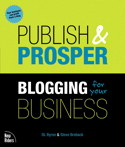Review: Publish and Prosper: Blogging for your Business
Review: Publish and Prosper: Blogging for your Business
By Nathan Segal
 |
Author: Steve Broback and DL Byron. Total Pages: 188 Publisher: New Riders Copyright: 2006 ISBN: 0321395387 |
Note: An excerpt from this book is available on WebReference.com: How Much Blog  and How Often?
Having just finished a major writing project, I've now had the opportunity to turn my attention towards new horizons. One of these is Blogging. Much has been written about the subject and in the process of my research, I realized I wanted to create an interactive blog, one that not only allowed me to post what I wanted, but would also give the users the opportunity to interact with me. When "Publish and Prosper: Blogging for your Business," came to my attention, it seemed like the perfect fit.
To give you an idea of what the book is about, here's the Table of Contents.
Table of ContentsChapter 1: Meet the BlogsChapter 2: Determining Your Focus Chapter 3: How Much Blog - and How Often Chapter 4: Designing for Readers Chapter 5: Tools and Implementation Chapter 6: Writing Your Blog Chapter 7: Launching Your Blog and Getting Noticed Chapter 8: Monitoring and Managing Your Blog Chapter 9: Beyond Blogging |
To get a sense of what's involved in blogging, it's necessary to go from theory to practice and in the book the authors recommend setting up a working blog. In this case, I decided to use WordPress on the advice of one of my colleagues.
In Chapter 2, you learn about what you want your blog will achieve and how to set it up correctly the first time. In my case, interactivity is important to me and I wanted to compare the features of different programs that allow for that. One such resource is Blog Software Breakdown, that compares different blogging applications.
As luck would have it, Chapter 2 dovetails nicely with some of the WordPress documentation, which takes the user into a planning session. There, you work with pencil and paper and learn how to set up your site before you actually build it.

The default process of setting up a blog in WordPress (which you can customize later).
In Chapter 3, the topic is "How Much Blog - and How Often?" Like Chapter 2, this step is important because it talks about dedication. Many people start blogs but don't have the resources for an ongoing commitment. The result is that 66% of blogs have not been updated in two months or more, and that almost 3 million blogs appear to have been abandoned. To avoid this fate, make sure you have the resources before you begin. As this chapter states, "Blogging is fairly simple - but it's not effortless."
Chapter 4 explores different design features for your blog and introduces you to the mechanics of organizing entries, tags, RSS and syndication, comments, trackbacks, search and more. One of the features that caught my eye was RSS (short for Really Simple Syndication) which allows users to subscribe to syndicated sites and receive updates as soon as they happen. This bypasses some of the problems one could encounter when sending out updates by email, where filters could block or remove your messages. Comments is another important feature that allows interactivity with your readers, where they can post comments (on articles you've posted) to your blog. This in not without risks due to the problem of "comment spam," where spammers use robots to browse thousands of blogs looking for an opportunity to insert their ads into your blog. One solution to this is employing a test, where a graphic is inserted, containing a word or numbers that the user has to correctly type in before they'll be allowed to post. Chapter 8 discusses commenting in greater detail.
Chapter 5 looks at the different tools available for building a successful blog. It's important to realize that you can't use them all, and if you try to do so, you could have problems with migration issues. At the end of this chapter is a table that helps you to determine which blog engine will be right for you.
An important part of generating revenue with a blog is having ads promoting affiliate marketing products. These products, when purchased by a user, generate commission income for the blogger. Another option is pay-per-click advertising. Google AdSense Ads are a perfect example. You'll see them in use on the JupiterMedia sites and in many other locations around the Web. The beauty of these ads is that they can be custom tailored to fit your site with different formats, images and color schemes.
Chapter 6 deals with the process of writing your blog. In order to have long-term success, there are three pillars to observe - your site must have excellent content, be regularly updated and must deliver value to your intended audience. To truly engage your readers, this chapter recommends that you want to adopt an authentic conversational tone and to avoid the "corpspeak" that's often found in press releases or PR departments. One book resource they recommend is "The Elements of Style," by William Strunk Jr. and E. B White. It's pocket-sized and is only 85 pages long, but it's number one on my list of resources. In my opinion, no serious writer should be without it.
In Chapter 7, you learn how to launch your blog and get noticed. There are variety of strategies presented here. One of these is to write original content, rather than posting information you've found somewhere else. However, if you do use previously published material, the authors advise you to avoid all blogs and other news mediums and rely instead on your own abilities for sourcing out information. When you find sites that offer content not previously posted to the blogosphere, you can be the one to introduce it. Other techniques include engaging the Blogosphere, learning the value of keywords, encouraging comments, trackbacks and more.
Note: According to Wikipedia, the term "Blogosphere" is the collective term encompassing all blogs as a community or social network.
Chapter 8 gives you information about how to manage your blog and offers a variety of methods "to monitor your blog's performance and stay on top of the converation generated by your posts." Some of the topics covered here are: comparing traffic, discovering trends, comments, interaction, defining the conversation and more.
In Chapter 9, one subject is about alternative forms of blogging. One of these is "moblogging," or mobile blogging, where you post updates to your blog using a cell phone or other portable devices. This allows you to add content to your blog without needing to have access to a computer or a standard Web connection.
Conclusion
If you're new to the topic of blogging, this book is an excellent starting point. It offers a detailed overview of the Blogging world and gives you strategies that you can use immediately, whether you're creating a blog as a hobby or for your business.
Created: March 27, 2003
Revised: July 28, 2006
URL: https://webreference.com/authoring/publish/1


 Find a programming school near you
Find a programming school near you